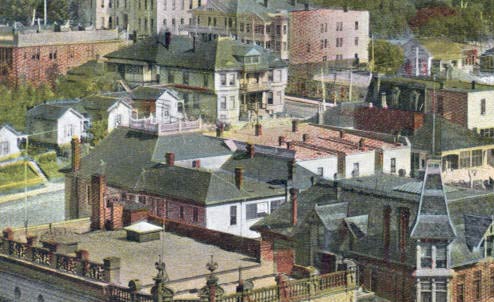
A Visit to Old Los
Angeles
10. Hill Street
(Part 1).
by
Brent C. Dickerson
Copyright © Brent C. Dickerson
Index to Episodes (click here)
A Visit to Hill Street south to
Fifth Street. Clay Street.
• Our family goes from oft-illustrated streets to those for which neither Charley nor Minnie nor indeed the resourceful young Frederick Johan can find many postcard views, even after having scoured all the city shops. Our tour of Hill Street begins with a close-up to the north from one of our bird's-eye views from the Court House tower. Here is a stretch of Hill Street on the block north of Temple where Hill meets the next east/west artery, California Street—we have come to a residential neighborhood, all the more residential the farther west we go up Bunker Hill. Bunker Hill is not a particular hill but rather a series of eminences which—before being largely graded away—loomed over the active little town of Los Angeles, cozily cradling its early development. How Bunker Hill came by its name is somewhat of a mystery, the "bunker" perhaps related to the nearby Fort Moore. The name "Bunker Hill" is seen on the Ord Plan de la Ciudad de los Angeles just west of the intersection of Hill and First Sts., that document being dated August 29, 1849. Another tale of its origin—unfortunately nearly twenty years too late, considering the appearance of the name on the 1849 Ord map—goes as follows: In 1867, Prudent Beaudry purchased for development some 20 acres of this hilly land reaching from Fort Hill south in an arc nearly to the intersection of Hope and Fifth Streets, paying $517 for it. His efforts on this project reached an important point in 1875 when he managed to get the area connected for water—you can't sell many lots for houses if there's no water!—and as this important point was reached on the 100th anniversary of the Battle of Bunker Hill in the Revolutionary War, he named the whole development "Bunker Hill."

• The Bradbury mansion stood at 147 N. Hill Street, just south of Court Street. This is the Bradbury of the Bradbury Building at Broadway and Third, and who built the Tajo Building just a stone's throw away at Broadway and First. The mansion had a varied career over its span, serving at times as a film studio and a restaurant. The street prominent in the foreground is the stub of Court Street as it approaches the near-cliff above Broadway. The Court Flight funicular would be built soon after this photograph was taken, the site of its upper terminus being at the lower left in this view.

• The lower 100s area of N. Hill Street is seen from the northeast here. Near center, the building with the two stories of breezeways is the Highland Villa, usually seen from the southeast. Here we see that the breezeways do not extend across the north side of the building. The Highland Villa was above the northwest corner of Hill and First Sts. The area we see beyond the HIghland Villa is all south of First Street. If we look carefully, we can see at upper right the little cupola of the Melrose Hotel, which we will visit on our walk down Grand Avenue. At lower left, we see a building with the word "Franklin" on the wall; this is a building on Broadway directly across the street from where Franklin Street—the former Jail Street—debouches onto Broadway. "This neighborhood is positively Alpine," quoth Minnie, fanning herself. "Nevertheless," responded Charley, "we can do without your yodeling."
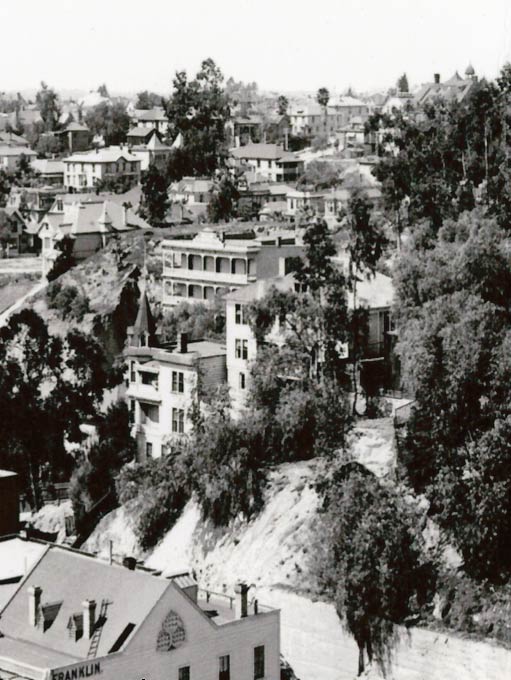
• The south 100s block of Hill Street is poorly documented! Young Frederick Johan searched the postcard shops in vain on my behalf, the best he could do being excerpts of the immediate area from other, more general, views. Here we would see the intersection in the lower right-hand corner, if it weren't for the tree. The building facing us in the right foreground—with the large arched window—is the police headquarters; the building endured for quite some time, but lost the decorative pediment at some point. In the rear of police headquarters was Central Receiving, a hospital which would attend to victims of crime and accident. The cupola which we see at mid-left is on the building at the southwest corner of Hill and Second streets (though the cupola itself is not quite at the corner); we will see it again from other directions. The houses on the slope to the right rise above Hill Street in a tiny neighborhood called Olive Court. Beyond is the bulk of the southern section of Bunker Hill.

• Between the building at the southwest corner of Broadway and First Street and Police Headquarters at the southeast corner of Hill Street and First Street was a small building which had to accommodate the rising ground. As the views of this area are generally from the vantage point of the Courthouse, and the Tajo Building gets in the way in that line of sight, this building is rarely seen. As we see, most of the premises is given over to printing-related pursuits, continuing the flavor bestowed on this precinct by the Los Angeles Times building kitty-corner at First and Broadway, and the Neuner Company just around the corner south on Broadway. Looking deep into the murk of the alley—be careful, it falls away steeply as it leaves First—we see the rear of the Neuner Company's building.
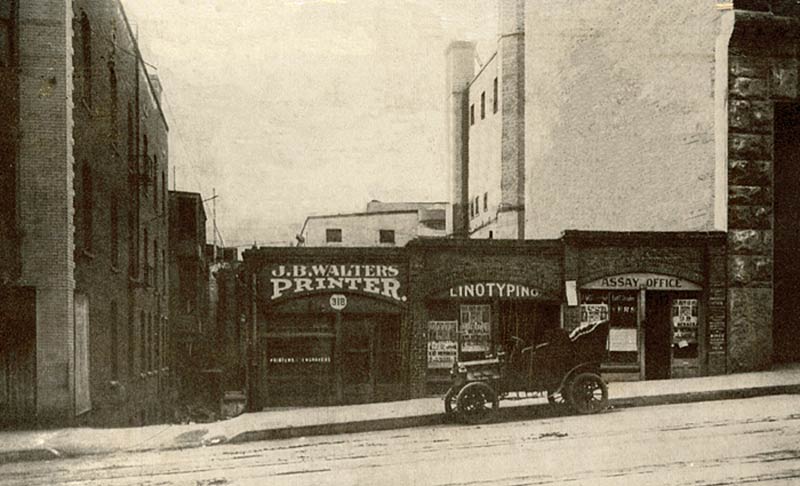
• With another view borrowed from another postcard, partially overlapping a previous view, we observe the block defined by Broadway, Hill, First, and Second. The crossroads at lower left is that of Broadway and First; the actual corner of Hill and First is just out of the picture to our right; but Hill continues diagonally across the center of the view, giving us some notion of the 100-200 blocks of S. Hill. We also see the "long series of eminences" previously referred to as it straggles south-westerly on the right of the picture.

• A quarter century later or so, the 100s block of S. Hill would look like this. The corner of Hill and First Sts. is hidden by the TIMES tower in the lower right foreground. Hill St. goes off to the left to meet Second Street, which can be seen crossing at upper left at its intersections with Clay Street and Olive Street. Hill's hill is being carved away for parking lots! The view is from today's City Hall.
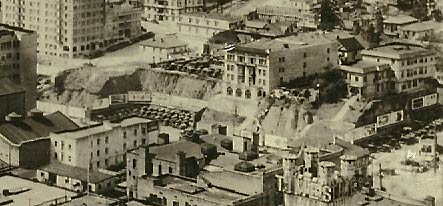
• At Clay Street—a lane
running between Hill St. and Olive St. for a short distance—and
Second Street is found the Hotel Northern. Clay Street looks very
insignificant between the old house at left, at the southeast corner of
the intersection, and the new Hotel Northern at the southwest corner! The
broad street in the foreground is Second Street, running east and
west.
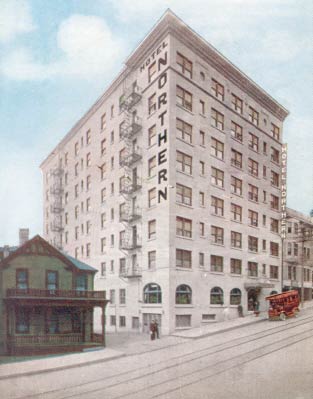
• In this picture, we can see more of Clay Street as it goes to the left—the postcard lab has conveniently removed the house which blocked the view. We can also can see farther up Second Street, to and past its intersection with Olive Street. Downtown continues to push outward into the suburbs.—we see a building under construction in the distance.

• The Hotel Northern dominates at right; but moving our focus to the left, we see the west face of the 200s block of Clay Street. The large building at the left on Clay Street is the Hillcrest Inn, later called the Hillcrest Hotel, a little beyond which (out of sight and on the other side of the 3rd Street Tunnel) is the track of Angels Flight.
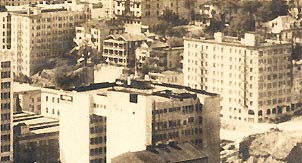
• Time to go back around the corner and return to Hill Street!—or at least, try to... In this view from the south, we rely once again on the building with the cupola, seen at center, for orientation: It's at the southwest corner of Hill and Second Sts., the little Crown Groceries store squatting visibly below it at the southeast corner. Between these two, unseen, its course going diagonally across the picture from mid left to lower right, is Hill Street. The house at the middle of the left edge is one in the Olive Court neighborhood, high on its hill over the 100s block of Hill Street below. The north face of the 300 west block of Second Street—a rare sight—can be seen just beyond the Crown Groceries building. Above that, on the far side of the block, on Broadway, is the Chamber of Commerce building. In the distance can be seen Hamburger's Great White Department Store, in the Phillips Block at Spring and Franklin Sts., while the Court House at Temple and Broadway looms over all. The highest house seen at upper left is in the Bunker Hill precinct served by the Court Flight funicular.
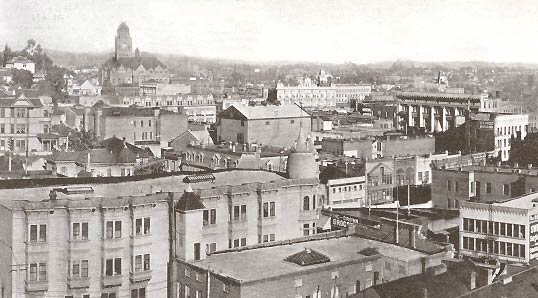
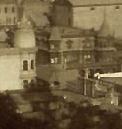 | • A tight shot of the corner of Hill and Second streets, from the southwest. We can pick out the very old-fashioned building at the northeast corner, kitty-corner to the cupola building. |
• A fuller view of that "very old-fashioned" building at Hill and Second Sts. The Chamber of Commerce building is at upper right; the long front of the Tajo Building at the northwest corner of Broadway and First Street peeks at us over intervening buildings at top left; the barn-like building at upper left center—which often sneaks into vistas over the city—is at the rear of the Neuner Company's headquarters on Broadway, and is perhaps their warehouse or workshop.
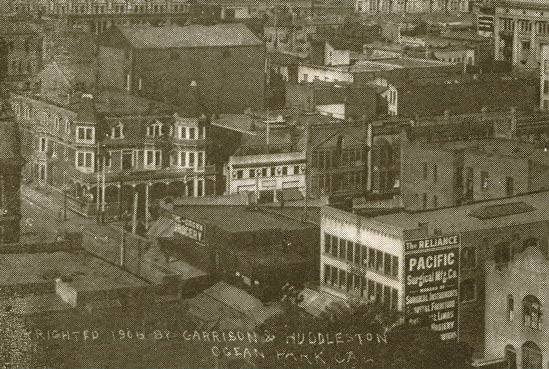
• Now we get a vague glimpse of most of the east side of the 200 block of Hill by this snippet from another view from the northwest. It is, as always, hard to pick out the line of Hill Street; but one can make a start of it by picking out our familiar building with the cupola at Hill and Second Sts. about a third of the way in from the right edge. The houses at left are in the Olive Court area. Just to the right of the tree at center is the building we saw a moment ago with the Crown Groceries store as tenant; the building in the foreground with its own cupola off to the right is the Argyle Hotel, which we will get a closer look at when we visit Olive Street.

• We return to a further segment of that view from the southwest. Once again, our familiar cupola is with us, now at the left; facing us are the buildings of the east side of the low 200s of the unseen Hill Street. Test your knowledge of Los Angeles! Can you pick out in this picture such landmarks as St. Vibiana's, the tower of the Hollenbeck Hotel, and the Orphan Asylum (which lattermost we will visit in a future episode)?

• The east face of the lower 200s had a residential feel for a short stretch.
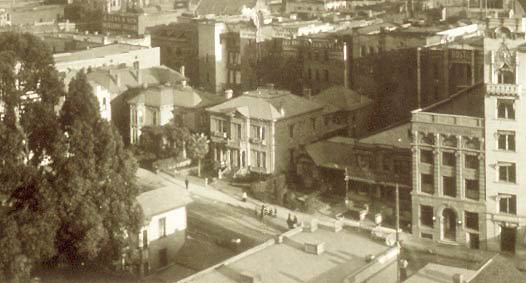
• The residence at the center of the previous view, at 232 S. Hill Street, was, at one point in its existence, a boarding house going by the name of The Abbey, as we see below. A bit of City Hall on Broadway can be seen in the background at right; the rear wall sign of the Ville de Paris dry goods store, also on Broadway, can be glimpsed towards the left. "Minnie," quoth I, "would you like to be an abbess? I'm sure you'd have quite dignified attire to wear." "With her abbey back to back with a Parisian dress store," remarked Charley, "I'm sure this abbess's attire would be the talk of the town." "And I suppose you think that's objectionable...?" said Minnie, raising one eyebrow. At least, the eyebrow would have been raised had it not been plucked.
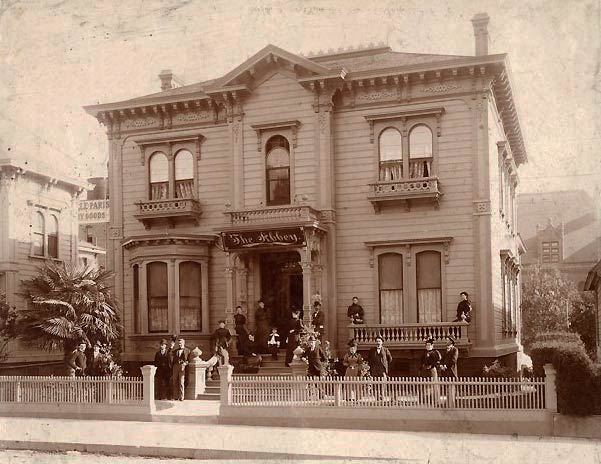
• We pass the Y.W.C.A. building, across the street at 231-235 S. Hill Street. "No, Charley," Mother quickly said, "you may not pay a courtesy call." But Minnie said, "I shall!", as she flounced up the steps. We get a glimpse of the buildings on the slope up to Olive Street behind.
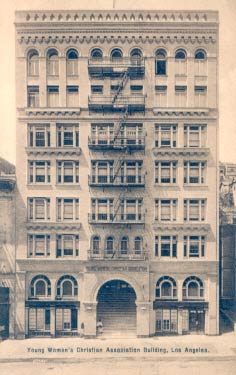
• Minnie emerged in due course. "Well," quoth she, "it was certainly well packed with women..." Charley eagerly responded, "Minnie is the only person I can think of who could come out of a women's association and report nothing but that it had women inside!" "Do I hear an echo?", I asked, innocently. "Then set ye a while and hear my humble tale," Minnie continued; "a very vigorous-looking young lady greeted me with a supernatural cheer as I walked in [Charley said, "It will be more moderate next time, no doubt."], took me by the sleeve—this one ["I'll make of note of it," said young Frederick Johan]—took me by this sleeve to one cozy room after another . . .
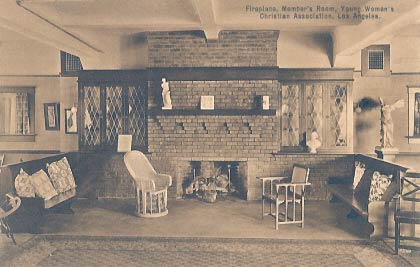
| • . . . At length, she took me out on a terrace and showed me the beautiful courtyard, where, suddenly, to the consternation of all, hideous winged creatures descended from the sky, took me in their arms, and then, laughing fiendishly, hurled me to the pavement below, where I was dashed into a million pieces ["This is a common claim," noted young Frederick Johan, "but it would take quite some time to count up such a number accurately."]! The talented young ladies in the building, however, immediately sewed me back together in the finest way possible, gave me an orange, bade me adieu, and thus it is that you again find me in your midst. And here is the very orange, proving the truth of it all." After a moment of silence, FJ asked, "What kind of thread did they use?" | 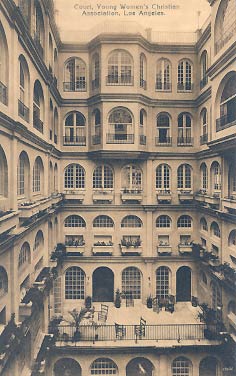 |
• Very nearly across the street from the Y.W.C.A. is the Independent Foresters' Bldg, at 246 S. Hill Street. The interior views are: top left, "Ladies Reception Room"; top right, "Court E.G. 33 Reading Room"; bottom left, "Court E.G. 33 Assembly Hall"; bottom right, "Candidates Reception Room."

| • The Hotel Belmont could be found at 251 S. Hill Street; this view dates from ca. 1940. "But when was it built?", asked Anna. | 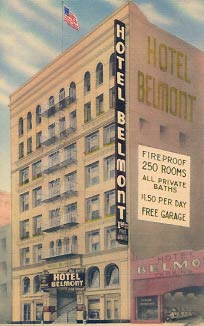 |
• The buildings at the northeast corner of Third and Hill show a mixture of old and new, as residential and private gives way to public business. Just left of the prominent modern office building in the middle of the view, known as the Exchange Building, at the northeast corner of Hill and Third, we see the Independent Foresters' Building again. In this view, Third Street stretches through the business district towards Main Street, where it seems from this standpoint to dead-end at the Liberty Theater. At center right, at the southeast corner of Third and Broadway, we see the Bradbury Building. City Hall juts up to enrich the skyline; and we can see Hamburger's Great White Department Store at Spring and Franklin Sts. as the uppermost building on the left edge of the view.
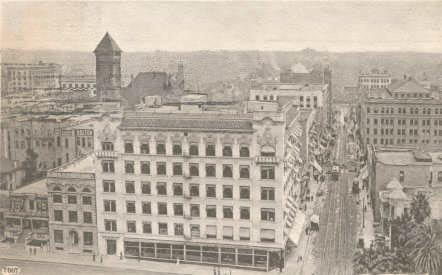
• At the southwest corner of Third and Hill we find an easy way to ascend to Olive Street—the funicular railway called Angel's Flight. We will reserve for our Olive Street adventure attentions to this beloved feature of Los Angeles' city-scape; but we take a glance or two at it and the Third Street tunnel as we proceed south on Hill Street. Here's an early view of just the southwest corner.

• And here's a more current view of both the northwest and southwest corners. Clay Street, unseen, runs left to right at about the halfway mark in this view immediately above the tunnel structure. The two young women in the right foreground have no doubt just walked out of the Y.W.C.A. around the corner to the right!
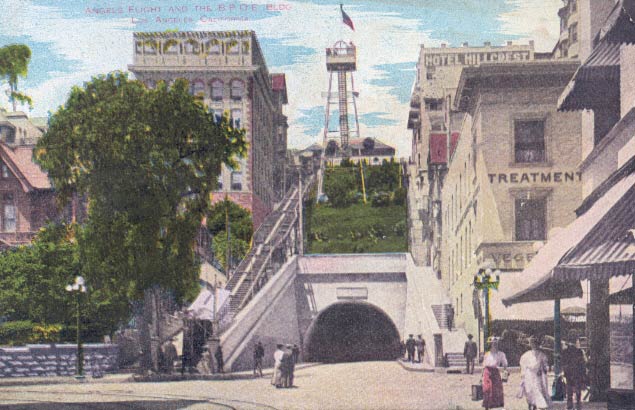
• A peek at the east side of the 300s block of Hill is afforded by bird's eye views courtesy Angel's Flight. Here we see the east face of Hill Street from Third Street, which we can see just a bit of at the lower left edge, to the middle of the block. The apartment building at center far right is the Aldine, which we will see better in a moment.
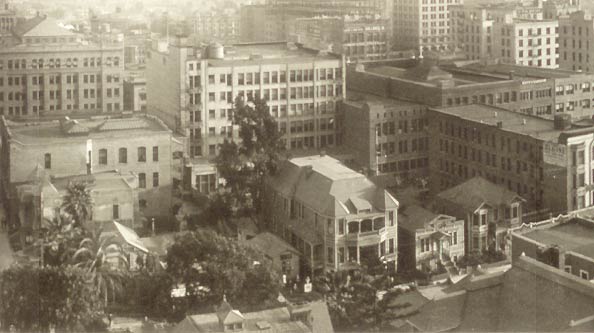
• At the bottom of this view, we see the middle of the east side of the block, several steps of urbanization in view, from old single family residences to modest boarding houses of the 1880s and 1890s hemmed in by newer commercial buildings. The alley between Broadway and Hill St. runs through the center of the picture, and beyond it we see the backs of the buildings on Broadway, including, at center right, the "City of London" store, the anglophile's answer to the tonier "Ville de Paris" emporium a block away. The massy brick building which dominates at upper right is the (back of the) Grant Building, the building on Broadway which sported the lady's shoe for us. At lower right, Hill Street approaches its corner with Fourth Street.
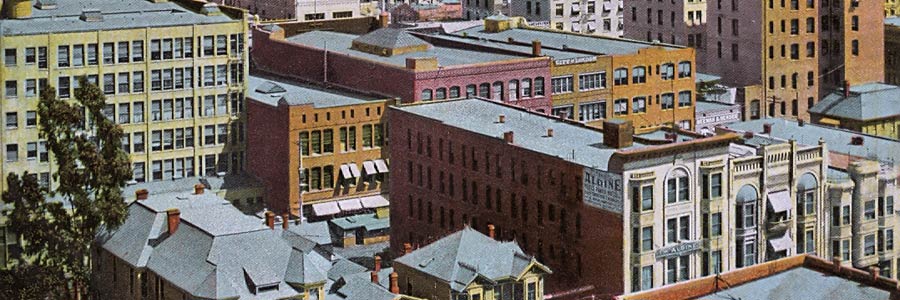
• We move just a bit farther along to the south. Now the Aldine is at the left, and we see all the way to Hill's corner with Fourth Street, near center right. The buildings on Hill Street are not as new and progressive as those on the streets eastward, but harken back to the 1890s and before in their styles and sizes.
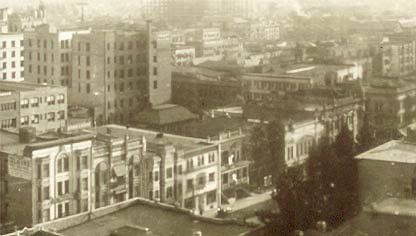
• Young Frederick Johan, who believes in completeness to the point of tedium, insisted that I include a view—"a confused view," I remonstrated—of the west side of the 300s block of South Hill Street. To orient yourself: We see it from the east. The cupola which we see just to the right of OWL to the left of center is at the northeast corner of Hill and Fourth Sts., and can be seen, with a little searching, near center right in the previous view, which is from the northwest. Hill Street runs unseen between the cupola and OWL, rightwards would be northwards. Devotees of Clay Street can examine the surroundings of its course, parallel to Hill Street, deeper into the picture; and close examination off towards the right will reveal a few feet of the track of Angels Flight. The building edging into the view close to us at the lower right edge is the Grant Building—that building with the shoe above it—at the northwest corner of Broadway and Fourth Street. ("There is more to be told about this picture!" exclaimed FJ. "Begone, child," said I; "I have said enough.")

• And indeed, what of Clay Street? Young Frederick Johan couldn't contemplate life without a closer view of it to show you, and so provided this peaceful-looking shot of the east side of the 300s block. Off to the left, Hill Street runs its course, its corner with Fourth Street very nearly at the center of this view. On Hill Street, at center left, the building bathed in light is the Fire Department headquarters at addresses 346-348, formerly the location of Engine Company No. 8. Off in the distance, we see the Hotel Lankershim looming at the intersection of Broadway and Seventh.
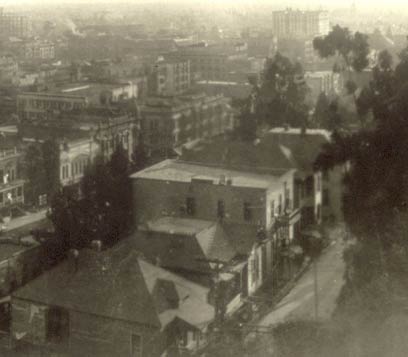
| • Below the houses we have just seen on Clay Street, and at the middle of the west side of Hill Street at address 351, we find Los Angeles' own Delmonico restaurant. The specialties—dear, why don't you practice making these for when I return?—are Spaghetti, Tagliarini, Ravioli, Risotto, and Gnocchi, announced the placard out front. "It sounds like the bill for the Friday night fights," said Charley. "No," was Papa's comment, "I think the Friday night fights would be with their wives," which brought a less than approving glance from Mother. | 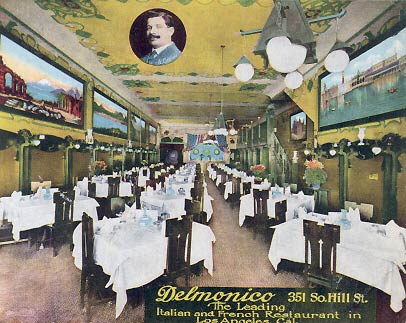 |
• To the left of the Kodak Store wall-sign can be seen a smaller wall-sign for Delmonico's, just a few doors to the right of this scene of the northwest corner of Hill Street and Fourth Street. The Hotel Antlers, seen in the distance at the mid-left, was at 421-423 W. Fourth Street. Between the corner and the hotel can be seen three old houses remaining from the area's residential era.
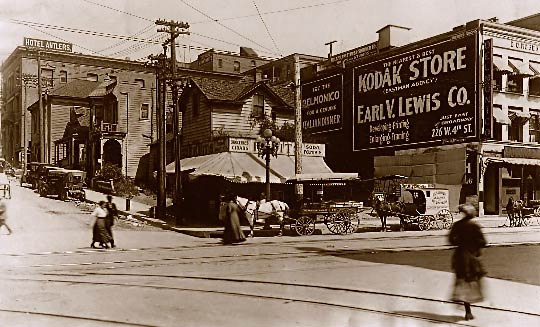
• Directly across the street, the northeast corner of Hill and Fourth Streets, we find ourselves once again very much in commercial downtown L.A., and appreciate one of its more exotic and fanciful buildings casting its joie de vivre over its surroundings and beholders. Looking east on Fourth, we can once again pick out the Union Trust Building—always an aid to orienting one's self downtown—two blocks away on Spring. Closer at hand, we see the rear of the Grant Building, which is at the corner of Fourth and Broadway; this was the building which memorably sported the lady's shoe for us.
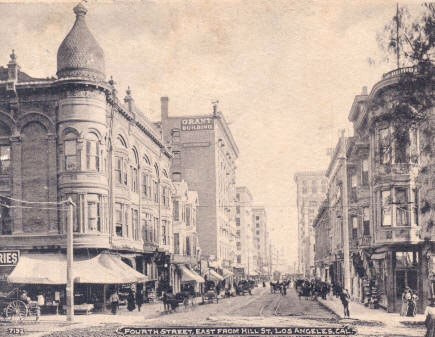
• On the southwest corner of Fourth and Hill, the Wright-Callender Building presides...
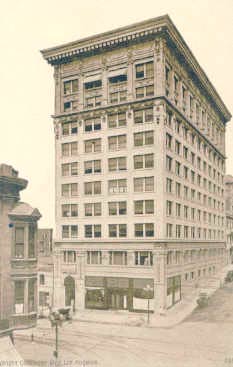
• ...While across the street, on the southeast corner, is the Hotel Sherman, displaying an older æsthetic.
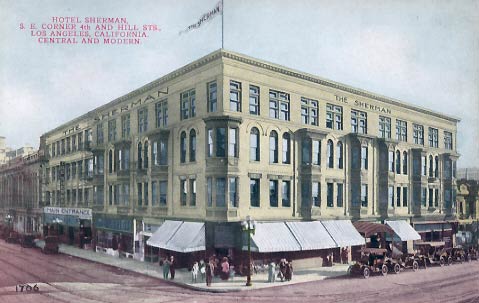
• And here is the whole intersection, from the standpoint of the roof of the Braly (Union Trust) Building back at Spring and 4th. The intersection of Hill and 4th Sts. is at the center of the view. The roof of the Angelus Hotel is at the bottom. The Grant Building, at Broadway and 4th, is prominent at mid-right, the lady's shoe on its roof now having been replaced by a barely-readable sign for Elgin Watches. The creamy brown Wright-Callender Building at Hill and 4th is prominent at center left. The low buildings at the northwest corner of the intersection which we saw in the "Kodak wall-sign" view a few moments ago have now been replaced by a skyscraper which hides the Hotel Antlers behind it. Clay Street finally ends at Fourth Street, just beyond this same skyscraper. Farther, we see Fourth Street rising to serve the heights of Bunker Hill.
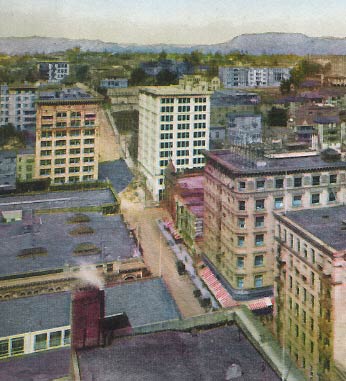
• In this view, we see the corner of Fourth and Hill streets with the domed building we saw close-up a moment ago; as we see as well the low 400s buildings on the east face of Hill Street. Behind the tree is the Hotel Sherman, while the Occidental Hotel is south of it at 428 S. Hill Street; the hotel's second-floor annex goes through to Broadway in a building which also hosts the Pin-Ton Candy Store on Broadway. The Wright-Callender Bldg. has not yet been built, and will occupy the central area in this view where the house and prominent tree below us are.

• With the Wright-Callender Building dominating at left, we look back up Hill Street from the middle of the 400s block towards the corner with Fourth and beyond.
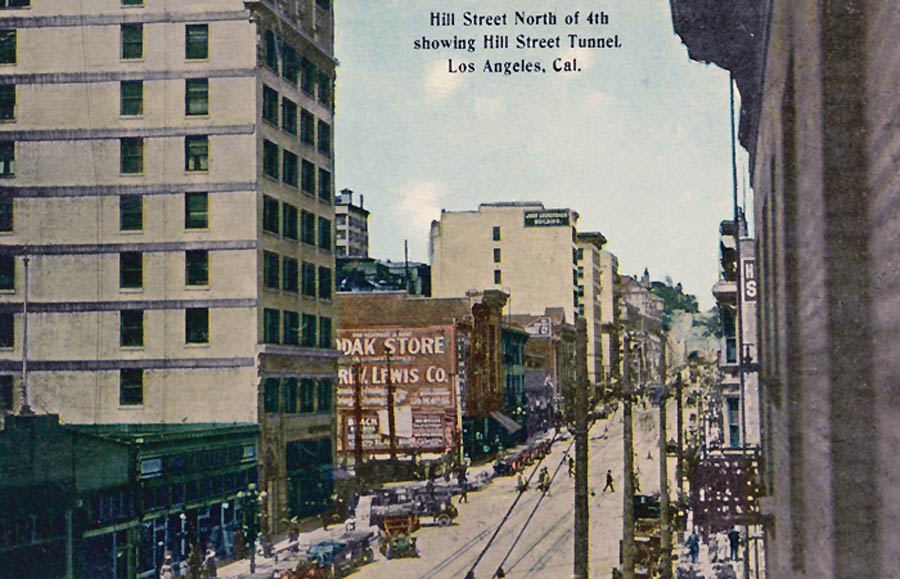
• With the Braly Bldg. (Union Trust Bldg.) on Spring Street presiding over the vista, we see in the foreground the east face of the lower 400s of S. Hill Street, the Hotel Sherman at left foreground. At right, in the background over on Broadway, we see the Broadway Central Bldg. in the course of construction.
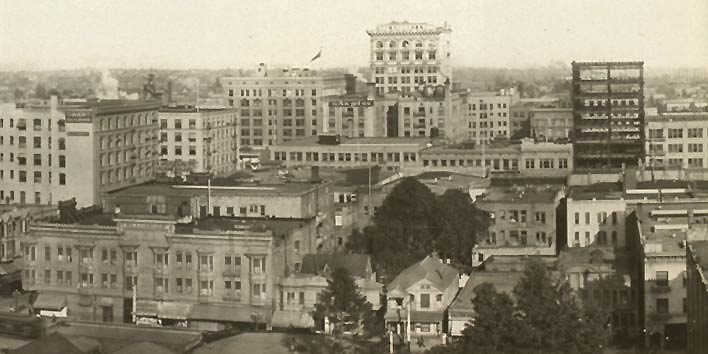
• Anna looked across the street. "Oh, my!" was all she said, the way in which she wrinkled up her nose being eloquent enough. The middle of the block was comprised of some sort of maintenance yard and shops for the trolleys. I suspect that the patrons of the front rooms of the Hotel Sherman did not linger long at their windows. In this view, the back of the Hotel Sherman is in the lower right-hand corner, and the south side of the Wright-Callender Bldg. is at upper right. Dominating at left is the Masonic Temple, erected in 1896. In the background, we see through to a bit of Olive Street. We mustn't look for Clay Street, as it came to its end at Fourth Street.
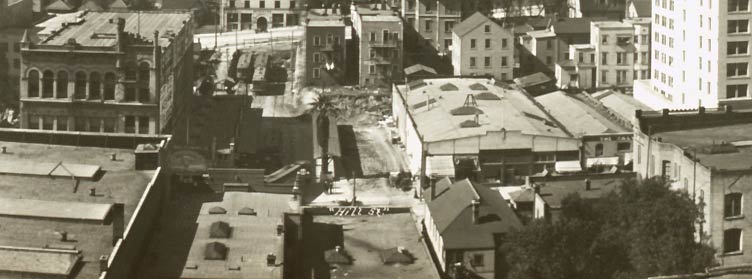
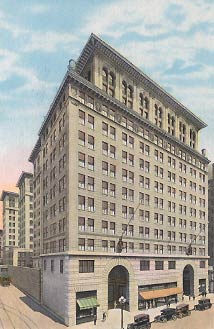
| • The Subway Terminal Building, at 417 S. Hill Street, was at length erected just south of the Wright-Callender Building. Anna looked at me and asked, "Ulf, dear, when was this one built?" "1925." "But isn't that nearly twenty years in the future?" "Yes," I said; "there are some mighty odd things about this visit of ours." "Just enjoy it," said Charley, trying to look nonchalant by brushing off his sleeve. |
• Who could resist going across the street and stepping for a moment into the Occidental Hotel? Certainly not I. I peeked into the homey-looking lobby of its annex.
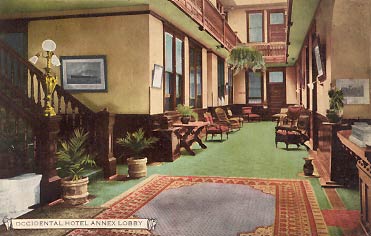
• The Occidental Hotel and several other small buildings adjacent to the south side of the Hotel Sherman would soon be replaced by the imposing Hotel Clark, which we see below, with a bit of the Hotel Sherman at lower left. The Occidental Hotel relocated a few doors down to a new location immediately south of the Hotel Clark; we can see it, in shadow, at lower right.

 | • Across the street, on the west side of Hill Street, was the Colby & Reed Cafeteria, at address 441-445. "And nearly next to that was an undertaker's," said Anna, looking over my shoulder as I wrote this; from the porch, Aunt Sigrid added, "People are dying to get in." |
• We look at the east face of the 400s block from the corner of Fifth and Hill. In the distance at the middle left, we see the domed building at Fourth and Hill which we have observed from other vantage points; the building which goes to (and beyond) the top margin of the view is the Hotel Clark. Just out of view at the left is the California Club building, which we will see in a moment. "I would be happy to pay a year's membership just to rest my feet in some quiet parlor there!" declared Minnie. Mother looked at her and said, "How quiet would it be if you were there, Minnie?".

• We find the California Club
building at the northwest corner of Hill Street and Fifth—throwing
into shadow a remnant of the street's old residential days. Look in the
twilight between the Club and the building with the wall-sign (the
undertaker's), and you'll find a pleasant, modest, Victorian home. These
were the suburbs not so many years before our visit!
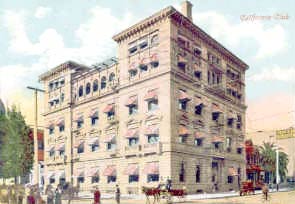
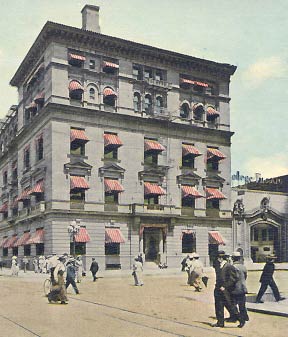 | • The California Club dominates this image; but tucked neatly onto the lot where a moment ago we saw that pleasant Victorian home we will now find the College Theater... |
• Dismiss all cares, and let joy be unconfined! Enjoy a performance at the College Theatre—"The Handsomest Theatre in the World," quoth the owners Mssrs. Prochazka & Hyman. "On the contrary," said Mother; "Have a care! And keep walking!"
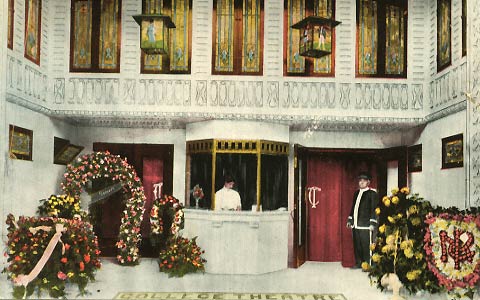
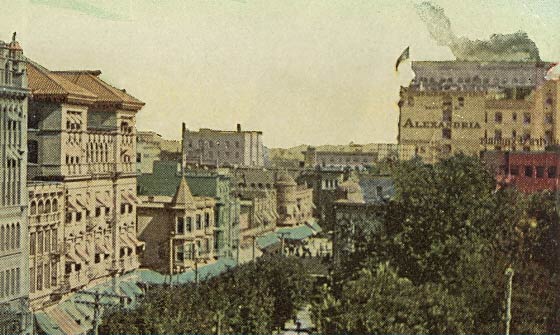 |
• In this view, we see the area of the intersection of Hill Street and Fifth Street, and in particular the north face of Fifth between Hill Street and Broadway. |
• Hill Street, from the tunnel through Bunker Hill above 1st Street to the intersection with Fifth Street.
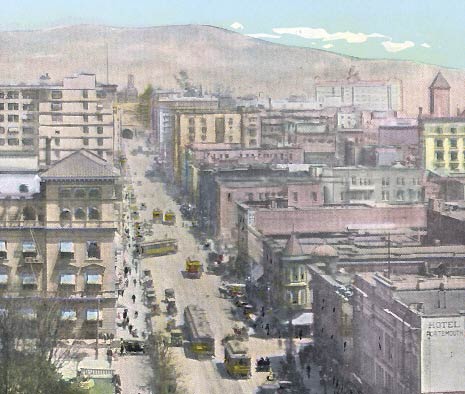
Return
to Broadway part three; or on
to Hill Street part 2 and Central Park . . .